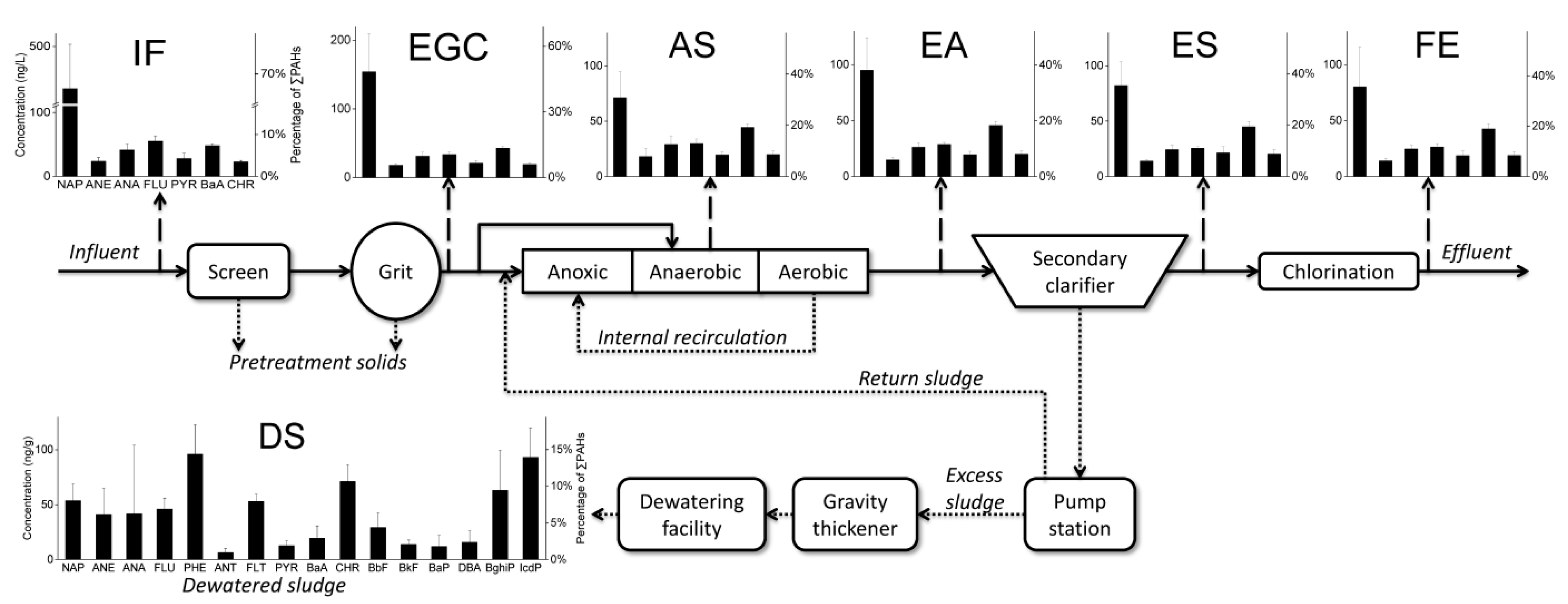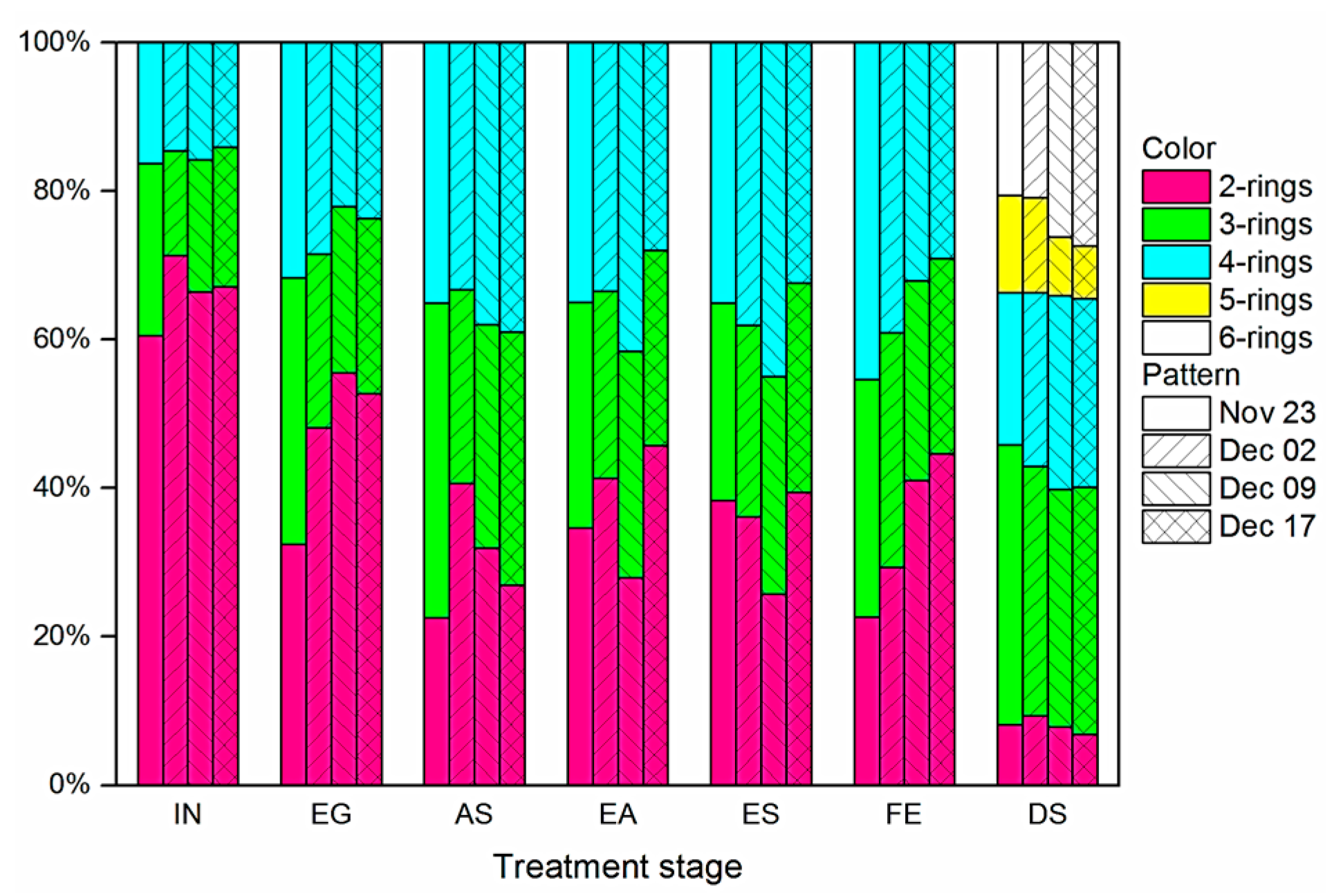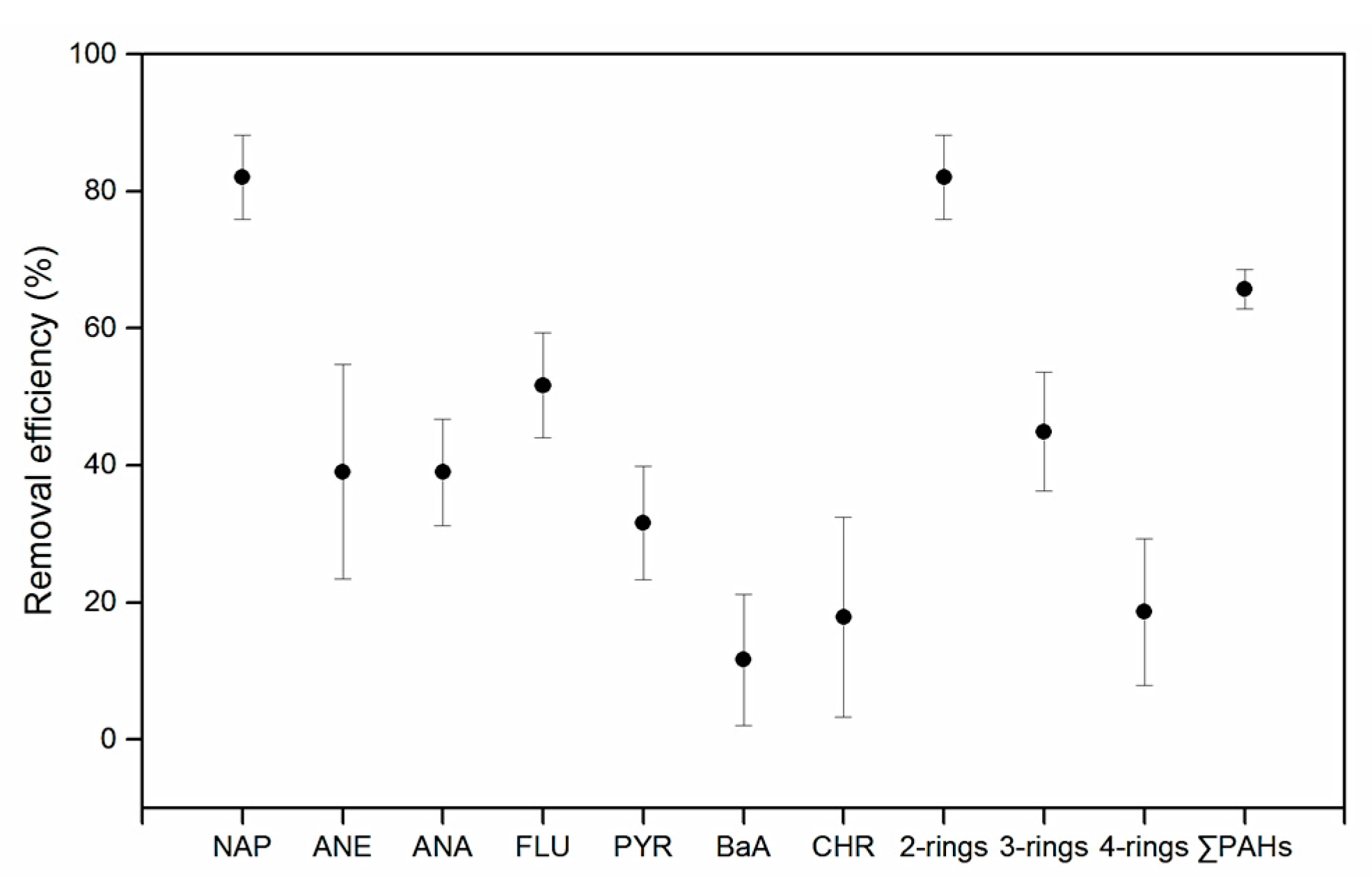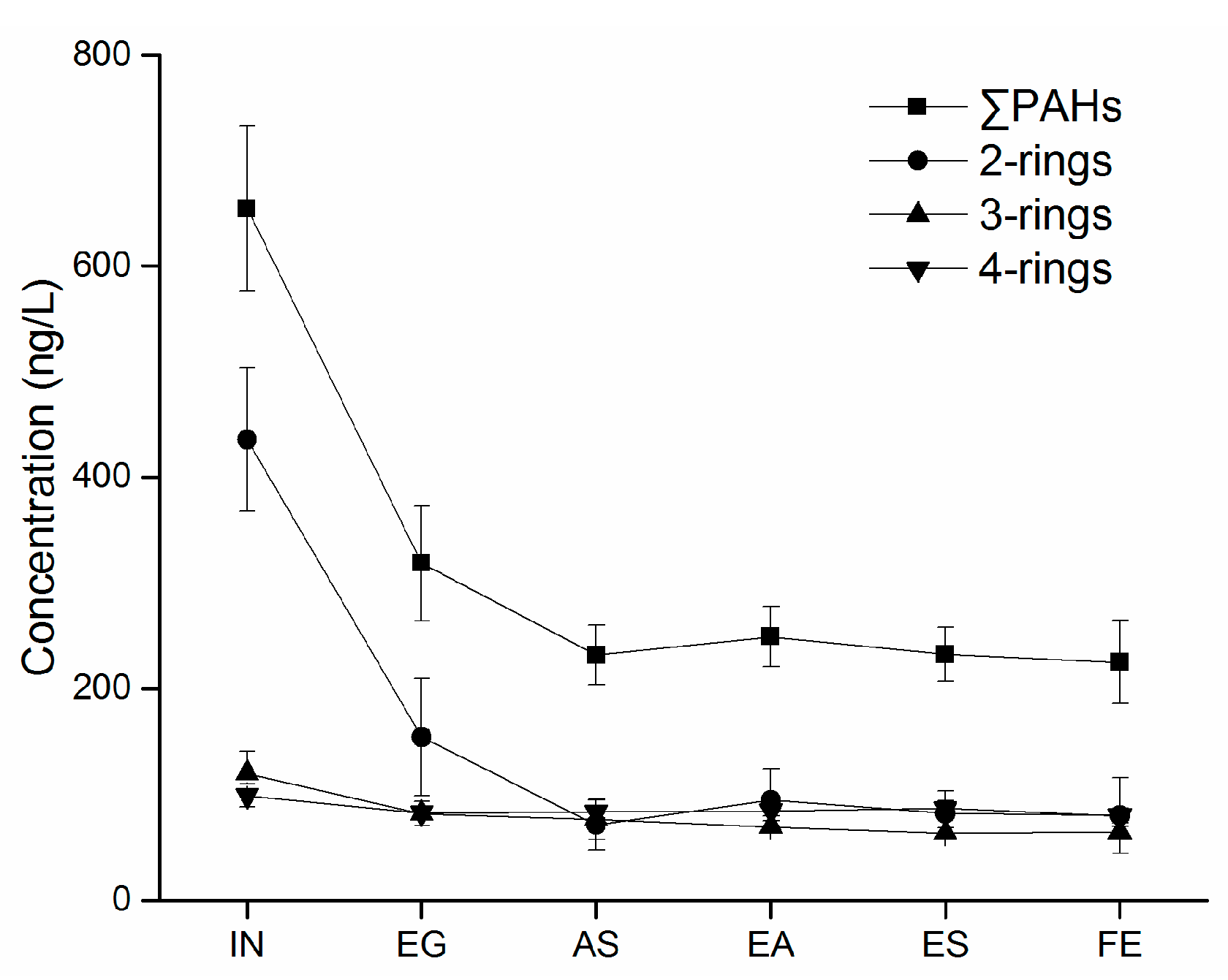Removal Efficiency and Risk Assessment of Polycyclic Aromatic Hydrocarbons in a Typical Municipal Wastewater Treatment Facility in Guangzhou, China
Abstract
:1. Introduction
2. Materials and Methods
2.1. Chemicals
2.2. Wastewater Treatment Plant
2.3. Sampling
2.4. Chemical Analyses
2.5. Quality Assurance and Quality Control
2.6. Toxicity Assessment
2.6.1. Toxic Equivalent Quantity
2.6.2. Health Risk
3. Results
3.1. PAHs in Dissolved Phase
3.1.1. Comparison between Different Dates
3.1.2. Concentrations of PAHs
3.1.3. Removal Efficiencies of PAHs
3.2. PAHs in Dewatered Sludge Samples
3.3. PAHs Source Analysis by Diagnostic Ratios
3.4. Risk Assessment
3.4.1. Effluent
3.4.2. Dewatered Sludge
4. Discussion
5. Conclusions
Acknowledgments
Author Contributions
Conflicts of Interest
References
- Balcioglu, E.B.; Aksu, A.; Balkis, N.; Ozturk, B. T-PAH contamination in mediterranean mussels (mytilus galloprovincialis, lamarck, 1819) at various stations of the turkish straits system. Mar. Pollut. Bull. 2014, 88, 344–346. [Google Scholar] [CrossRef] [PubMed]
- Wu, Y.; Luo, Y.; Zou, D.; Ni, J.; Liu, W.; Teng, Y.; Li, Z. Bioremediation of polycyclic aromatic hydrocarbons contaminated soil with Monilinia sp.: Degradation and microbial community analysis. Biodegradation 2008, 19, 247–257. [Google Scholar] [CrossRef] [PubMed]
- Zhang, W.; Wei, C.; Chai, X.; He, J.; Cai, Y.; Ren, M.; Yan, B.; Peng, P.; Fu, J. The behaviors and fate of polycyclic aromatic hydrocarbons (PAHs) in a coking wastewater treatment plant. Chemosphere 2012, 88, 174–182. [Google Scholar] [CrossRef] [PubMed]
- Tao, Y.; Yu, J.; Xue, B.; Yao, S.; Wang, S. Precipitation and temperature drive seasonal variation in bioaccumulation of polycyclic aromatic hydrocarbons in the planktonic food webs of a subtropical shallow eutrophic lake in China. Sci. Total Environ. 2017, 583, 447–457. [Google Scholar] [CrossRef] [PubMed]
- Mori, J.; Sæbø, A.; Hanslin, H.M.; Teani, A.; Ferrini, F.; Fini, A.; Burchi, G. Deposition of traffic-related air pollutants on leaves of six evergreen shrub species during a mediterranean summer season. Urban For. Urban Green. 2015, 14, 264–273. [Google Scholar] [CrossRef]
- Zhou, W.; Fu, D.; Sun, Z. Determination of black list of China’s priority pollutants in water. Res. Environ. Sci. 1991, 4, 9–12. [Google Scholar]
- Commission, E. Directive 2013/39/eu of the european parliament and of the council amending directives 2000/60/ec and 2008/105/ec as regards priority substances in the field of water policy. Off. J. Eur. Union 2013, 226, 1–17. [Google Scholar]
- US Environmental Protection Agency. Regional Screening Levels (Formerly Hhmssl—Human Health Medium-Specific Screening Levels). Available online: https://www.epa.gov/risk/regional-screening-levels-rsls-generic-tables-may-2016 (accessed on 20 March 2017).
- Ministry of Housing Spatial Planning and Environment. Environmental Quality Objectives in the Netherlands: A Review of Environmental Quality Objectives and Their Policy Framework in the Netherlands; Ministry of Housing, Spatial Planning and Environment: Hague, The Netherlands, 1994.
- Ministry of Housing and Urban-Rural Development. Disposal of Sludge from Municipal Wastewater Treatment Plant-Control Standards for Agricultural Use (cj/t 309–2009); Standards Press of China: Beijing, China, 2009.
- Schwarzenbach, R.P.; Gschwend, P.M.; Imboden, D.M. Environmental Organic Chemistry, 2nd ed.; John Wiley & Sons: Hoboken, NJ, USA, 2003. [Google Scholar]
- Wang, X.-H.; Wang, X.; Huppes, G.; Heijungs, R.; Ren, N.-Q. Environmental implications of increasingly stringent sewage discharge standards in municipal wastewater treatment plants: Case study of a cool area of China. J. Clean. Prod. 2015, 94, 278–283. [Google Scholar] [CrossRef]
- Zeng, S.; Chen, X.; Dong, X.; Liu, Y. Efficiency assessment of urban wastewater treatment plants in China: Considering greenhouse gas emissions. Resour. Conserv. Recycl. 2017, 120, 157–165. [Google Scholar] [CrossRef]
- Zhang, M.; Wang, C.; Peng, Y.; Wang, S.; Jia, F.; Zeng, W. Organic substrate transformation and sludge characteristics in the integrated anaerobic anoxic oxic–biological contact oxidation (a2/o-bco) system treating wastewater with low carbon/nitrogen ratio. Chem. Eng. J. 2016, 283, 47–57. [Google Scholar] [CrossRef]
- Ma, Y.; Peng, Y.; Wang, X. Improving nutrient removal of the aao process by an influent bypass flow by denitrifying phosphorus removal. Desalination 2009, 246, 534–544. [Google Scholar] [CrossRef]
- Wu, Q.; Leung, J.Y.; Tam, N.F.; Chen, S.; Mai, B.; Zhou, X.; Xia, L.; Geng, X. Biological risk and pollution history of polycyclic aromatic hydrocarbons (PAHs) in nansha mangrove, south China. Mar. Pollut. Bull. 2014, 85, 92–98. [Google Scholar] [CrossRef] [PubMed]
- US Environmental Protection Agency. Epa Method 8270d (sw-846): Semivolatile Organic Compounds by Gas Chromatography/Mass Spectrometry (gc-ms). Available online: https://www.epa.gov/sites/production/files/2015–07/documents/epa-8270d.pdf (accessed on 20 March 2017).
- Tsai, P.-J.; Shih, T.-S.; Chen, H.-L.; Lee, W.-J.; Lai, C.-H.; Liou, S.-H. Assessing and predicting the exposures of polycyclic aromatic hydrocarbons (PAHs) and their carcinogenic potencies from vehicle engine exhausts to highway toll station workers. Atmos. Environ. 2004, 38, 333–343. [Google Scholar] [CrossRef]
- Bortey-Sam, N.; Ikenaka, Y.; Nakayama, S.M.; Akoto, O.; Yohannes, Y.B.; Baidoo, E.; Mizukawa, H.; Ishizuka, M. Occurrence, distribution, sources and toxic potential of polycyclic aromatic hydrocarbons (PAHs) in surface soils from the kumasi metropolis, ghana. Sci. Total Environ. 2014, 496, 471–478. [Google Scholar] [CrossRef] [PubMed]
- Nguyen, T.C.; Loganathan, P.; Nguyen, T.V.; Vigneswaran, S.; Kandasamy, J.; Slee, D.; Stevenson, G.; Naidu, R. Polycyclic aromatic hydrocarbons in road-deposited sediments, water sediments, and soils in sydney, australia: Comparisons of concentration distribution, sources and potential toxicity. Ecotoxicol. Environ. Saf. 2014, 104, 339–348. [Google Scholar] [CrossRef] [PubMed]
- Zheng, B.; Wang, L.; Lei, K.; Nan, B. Distribution and ecological risk assessment of polycyclic aromatic hydrocarbons in water, suspended particulate matter and sediment from daliao river estuary and the adjacent area, China. Chemosphere 2016, 149, 91–100. [Google Scholar] [CrossRef] [PubMed]
- Zhang, L.; Dong, L.; Ren, L.; Shi, S.; Zhou, L.; Zhang, T.; Huang, Y. Concentration and source identification of polycyclic aromatic hydrocarbons and phthalic acid esters in the surface water of the yangtze river delta, China. J. Environ. Sci. 2012, 24, 335–342. [Google Scholar] [CrossRef]
- US Environmental Protection Agency. Guidelines for the Health Risk Assessment of Chemical Mixtures; EPA/630/R-98/002; Office of Research and Development: Washington, DC, USA, 1986.
- US Environmental Protection Agency. Supplemental Risk Assessment Guidance for the Superfund Program. Part 1. Guidance for Public Health Risk Assessments; EPA/901/5–89/001; US Environmental Protection Agency Region 1 Risk Assessment Work Group: Washington, DC, USA, 1989.
- Krishnan, K.; Paterson, J.; Williams, D.T. Health risk assessment of drinking water contaminants in canada: The applicability of mixture risk assessment methods. Regul. Toxicol. Pharmacol. 1997, 26, 179–187. [Google Scholar] [CrossRef] [PubMed]
- US Environmental Protection Agency. Available Information on Assessment Exposure from Pesticides in Food; Office of Pesticides Programs: Washington, DC, USA, 2000.
- US Environmental Protection Agency. Superfund Public Health Evaluation Manual; EPA/540/1–86/060; Office of Emergency and Remedial Response: Washington, DC, USA, 1986.
- Qiao, M.; Qi, W.; Liu, H.; Qu, J. Occurrence, behavior and removal of typical substituted and parent polycyclic aromatic hydrocarbons in a biological wastewater treatment plant. Water Res. 2014, 52, 11–19. [Google Scholar] [CrossRef] [PubMed]
- Foan, L.; Domercq, M.; Bermejo, R.; Santamaria, J.M.; Simon, V. Mosses as an integrating tool for monitoring PAH atmospheric deposition: Comparison with total deposition and evaluation of bioconcentration factors. A year-long case-study. Chemosphere 2015, 119, 452–458. [Google Scholar] [CrossRef] [PubMed]
- Azpíroz, G.; Blanco, C.G.; Banciella, C. The use of solvents for purifying industrial naphthalene from coal tar distilled oils. Fuel Process. Technol. 2008, 89, 111–117. [Google Scholar] [CrossRef]
- Tian, W.; Bai, J.; Liu, K.; Sun, H.; Zhao, Y. Occurrence and removal of polycyclic aromatic hydrocarbons in the wastewater treatment process. Ecotoxicol. Environ. Saf. 2012, 82, 1–7. [Google Scholar] [CrossRef] [PubMed]
- Ozaki, N.; Takamura, Y.; Kojima, K.; Kindaichi, T. Loading and removal of PAHs in a wastewater treatment plant in a separated sewer system. Water Res. 2015, 80, 337–345. [Google Scholar] [CrossRef] [PubMed]
- Bergqvist, P.A.; Augulytė, L.; Jurjonienė, V. Pah and pcb removal efficiencies in umeå (Sweden) and šiauliai (Lithuania) municipal wastewater treatment plants. Water Air Soil Pollut. 2006, 175, 291–303. [Google Scholar] [CrossRef]
- Vogelsang, C.; Grung, M.; Jantsch, T.G.; Tollefsen, K.E.; Liltved, H. Occurrence and removal of selected organic micropollutants at mechanical, chemical and advanced wastewater treatment plants in norway. Water Res. 2006, 40, 3559–3570. [Google Scholar] [CrossRef] [PubMed]
- Byrns, G. The fate of xenobiotic organic compounds in wastewater treatment plants. Water Res. 2001, 35, 2523–2533. [Google Scholar] [CrossRef]
- Manoli, E.; Samara, C. The removal of polycyclic aromatic hydrocarbons in the wastewater treatment process: Experimental calculations and model predictions. Environ. Pollut. 2008, 151, 477–485. [Google Scholar] [CrossRef] [PubMed]
- Man, Y.B.; Chow, K.L.; Cheng, Z.; Mo, W.Y.; Chan, Y.H.; Lam, J.C.; Lau, F.T.; Fung, W.C.; Wong, M.H. Profiles and removal efficiency of polycyclic aromatic hydrocarbons by two different types of sewage treatment plants in Hong Kong. J. Environ. Sci. 2017, 53, 196–206. [Google Scholar] [CrossRef] [PubMed]
- Ding, J.; Chen, B.; Zhu, L. Biosorption and biodegradation of polycyclic aromatic hydrocarbons by phanerochaete chrysosporium in aqueous solution. Chin. Sci. Bull. 2012, 58, 613–621. [Google Scholar] [CrossRef]
- Cai, Q.Y.; Mo, C.H.; Wu, Q.T.; Zeng, Q.Y.; Katsoyiannis, A. Occurrence of organic contaminants in sewage sludges from eleven wastewater treatment plants, China. Chemosphere 2007, 68, 1751–1762. [Google Scholar] [CrossRef] [PubMed]
- Yunker, M.B.; Macdonald, R.W.; Vingarzan, R.; Mitchell, R.H.; Goyette, D.; Sylvestre, S. Pahs in the fraser river basin: A critical appraisal of PAH ratios as indicators of PAH source and composition. Organ. Geochem. 2002, 33, 489–515. [Google Scholar] [CrossRef]
- Budzinski, H.; Jones, I.; Bellocq, J.; Piérard, C.; Garrigues, P. Evaluation of sediment contamination by polycyclic aromatic hydrocarbons in the gironde estuary. Mar. Chem. 1997, 58, 85–97. [Google Scholar] [CrossRef]
- Zhang, W.; Wei, C.; Feng, C.; Yan, B.; Li, N.; Peng, P.; Fu, J. Coking wastewater treatment plant as a source of polycyclic aromatic hydrocarbons (PAHs) to the atmosphere and health-risk assessment for workers. Sci. Total Environ. 2012, 432, 396–403. [Google Scholar] [CrossRef] [PubMed]
- Katsoyiannis, A.; Terzi, E.; Cai, Q.Y. On the use of PAH molecular diagnostic ratios in sewage sludge for the understanding of the PAH sources. Is this use appropriate? Chemosphere 2007, 69, 1337–1339. [Google Scholar] [CrossRef] [PubMed]
- Tobiszewski, M.; Namiesnik, J. Pah diagnostic ratios for the identification of pollution emission sources. Environ. Pollut. 2012, 162, 110–119. [Google Scholar] [CrossRef] [PubMed]
- Mansuy-Huault, L.; Regier, A.; Faure, P. Analyzing hydrocarbons in sewer to help in PAH source apportionment in sewage sludges. Chemosphere 2009, 75, 995–1002. [Google Scholar] [CrossRef] [PubMed]
- Ministry of Health of the People’s Republic of China. Environmental pollution health impact assessment standard. J. Environ. Health 1999, 16, 248–256. [Google Scholar]
- Lee, I.S.; Sim, W.J.; Kim, C.W.; Chang, Y.S.; Oh, J.E. Characteristic occurrence patterns of micropollutants and their removal efficiencies in industrial wastewater treatment plants. J. Environ. Monit. 2011, 13, 391–397. [Google Scholar] [CrossRef] [PubMed]
- Qiao, M.; Qi, W.; Liu, H.; Qu, J. Oxygenated, nitrated, methyl and parent polycyclic aromatic hydrocarbons in rivers of haihe river system, China: Occurrence, possible formation, and source and fate in a water-shortage area. Sci. Total Environ. 2014, 481, 178–185. [Google Scholar] [CrossRef] [PubMed]
- Qi, W.; Liu, H.; Pernet-Coudrier, B.; Qu, J. Polycyclic aromatic hydrocarbons in wastewater, WWTPs effluents and in the recipient waters of Beijing, China. Environ. Sci. Pollut. Res. Int. 2013, 20, 4254–4260. [Google Scholar] [CrossRef] [PubMed]
- Zheng, B.; Ma, Y.; Qin, Y.; Zhang, L.; Zhao, Y.; Cao, W.; Yang, C.; Han, C. Distribution, sources, and risk assessment of polycyclic aromatic hydrocarbons (PAHs) in surface water in industrial affected areas of the three gorges reservoir, China. Environ. Sci. Pollut. Res. Int. 2016, 23, 23485–23495. [Google Scholar] [CrossRef] [PubMed]




| Date | Stage | 2-Rings | 3-Rings | 4-Rings | ∑LMW PAHs | ∑HMW PAHs | ∑PAHs | ||||
|---|---|---|---|---|---|---|---|---|---|---|---|
| NAP | ANE | ANA | FLU | PYR | BaA | CHR | |||||
| 23 November | IN | 335.66 | 21.06 | 50.82 | 56.49 | 19.14 | 48.06 | 23.13 | 464.03 | 90.33 | 554.36 |
| EG | 85.15 | 19.78 | 38.33 | 36.13 | 16.14 | 46.17 | 20.87 | 179.39 | 83.18 | 262.57 | |
| AS | 55.91 | 29.16 | 39.83 | 35.95 | 15.36 | 47.90 | 23.70 | 160.85 | 86.96 | 247.81 | |
| EA | 86.19 | 18.41 | 30.51 | 26.41 | 14.95 | 49.47 | 22.44 | 161.52 | 86.86 | 248.38 | |
| ES | 100.19 | 15.25 | 29.27 | 25.03 | 15.54 | 51.04 | 25.04 | 169.74 | 91.63 | 261.37 | |
| FE | 43.51 | 11.13 | 28.07 | 22.37 | 14.73 | 49.18 | 23.44 | 105.08 | 87.35 | 192.44 | |
| 2 December | IN | 449.82 | 16.64 | 28.88 | 43.49 | 22.43 | 47.45 | 22.05 | 538.84 | 91.93 | 630.77 |
| EG | 142.31 | 16.16 | 24.46 | 28.46 | 21.53 | 41.39 | 21.27 | 211.39 | 84.19 | 295.58 | |
| AS | 103.53 | 14.86 | 24.19 | 27.51 | 22.37 | 44.11 | 18.42 | 170.09 | 84.90 | 254.99 | |
| EA | 108.20 | 14.04 | 22.62 | 29.25 | 19.62 | 46.94 | 21.04 | 174.11 | 87.60 | 261.70 | |
| ES | 84.94 | 13.97 | 20.88 | 25.70 | 29.07 | 42.15 | 18.21 | 145.50 | 89.44 | 234.93 | |
| FE | 55.66 | 13.69 | 20.83 | 25.34 | 16.24 | 39.18 | 18.70 | 115.52 | 74.12 | 189.64 | |
| 9 December | IN | 480.58 | 27.31 | 41.74 | 59.41 | 36.59 | 51.87 | 25.75 | 609.04 | 114.21 | 723.24 |
| EG | 217.03 | 18.90 | 31.12 | 37.77 | 24.83 | 43.08 | 18.33 | 304.81 | 86.24 | 391.05 | |
| AS | 73.94 | 14.53 | 26.56 | 28.68 | 21.56 | 45.19 | 21.04 | 143.70 | 87.79 | 231.49 | |
| EA | 58.82 | 13.36 | 22.95 | 27.69 | 21.83 | 45.34 | 20.14 | 122.81 | 87.32 | 210.13 | |
| ES | 51.19 | 12.87 | 21.71 | 23.77 | 21.04 | 46.37 | 22.07 | 109.55 | 89.49 | 199.04 | |
| FE | 107.75 | 17.02 | 25.19 | 28.54 | 24.24 | 42.54 | 17.46 | 178.49 | 84.23 | 262.73 | |
| 17 December | IN | 475.85 | 29.38 | 43.63 | 60.99 | 33.21 | 45.57 | 20.71 | 609.85 | 99.48 | 709.33 |
| EG | 171.78 | 16.11 | 29.97 | 30.73 | 20.77 | 40.36 | 15.81 | 248.59 | 76.94 | 325.53 | |
| AS | 51.55 | 13.77 | 24.80 | 26.77 | 18.63 | 40.18 | 15.95 | 116.90 | 74.76 | 191.66 | |
| EA | 126.31 | 13.49 | 28.28 | 30.83 | 20.97 | 40.54 | 15.76 | 198.91 | 77.27 | 276.18 | |
| ES | 92.23 | 13.40 | 25.07 | 27.36 | 20.14 | 40.02 | 15.64 | 158.07 | 75.81 | 233.88 | |
| FE | 113.67 | 13.58 | 24.51 | 28.86 | 19.21 | 39.42 | 15.43 | 180.62 | 74.06 | 254.67 | |
| Ring | Compounds | Dewatered Sludge | Soil Standards | TEF a | |||||||||
|---|---|---|---|---|---|---|---|---|---|---|---|---|---|
| 23 November | 2 December | 9 December | 17 December | MHSPE b | RCLs c | CJ/T d | |||||||
| 2 | NAP | 76.10 | 51.22 | 45.87 | 41.53 | 15 | - | - | 0.001 | ||||
| 3 | ANE | 10.48 | 32.85 | 58.21 | 62.44 | - | - | - | 0.001 | ||||
| ANA | 134.88 | 18.80 | 0.34 | 13.52 | - | - | - | 0.001 | |||||
| FLU | 58.81 | 48.74 | 40.28 | 36.22 | - | - | - | 0.001 | |||||
| PHE | 135.52 | 76.88 | 84.54 | 87.32 | 50 | - | - | 0.001 | |||||
| ANT | 11.28 | 7.13 | 4.41 | 2.62 | 50 | - | - | 0.01 | |||||
| 4 | FLT | 59.58 | 57.47 | 49.07 | 45.61 | 15 | - | - | 0.001 | ||||
| PYR | 18.55 | 7.88 | 13.21 | 11.28 | - | - | - | 0.001 | |||||
| BaA e | 18.59 | 4.53 | 25.49 | 29.28 | 20 | 160 | - | 0.1 | |||||
| CHR e | 93.61 | 58.39 | 64.74 | 68.13 | 20 | 16,000 | - | 0.01 | |||||
| 5 | BbF e | 47.77 | 29.64 | 21.72 | 17.91 | - | 160 | - | 0.1 | ||||
| BkF e | 19.24 | 9.87 | 11.60 | 14.11 | 25 | 1600 | - | 0.1 | |||||
| BaP e | 26.06 | 13.37 | 3.56 | 4.88 | 25 | 16 | 2000 | 1 | |||||
| DBA e | 29.72 | 17.40 | 9.53 | 6.32 | 25 | 16 | - | 1 | |||||
| 6 | BghiP | 117.91 | 46.79 | 43.54 | 44.13 | - | - | - | 0.01 | ||||
| IcdP e | 73.23 | 67.69 | 109.94 | 121.87 | 20 | 160 | - | 0.1 | |||||
| ∑PAHs-carc | 308.21 | 200.88 | 246.58 | 262.52 | - | - | - | - | |||||
| ∑LMW PAHs | 427.08 | 235.62 | 233.65 | 243.66 | - | - | - | - | |||||
| ∑HMW PAHs | 504.25 | 313.01 | 352.41 | 363.54 | - | - | - | - | |||||
| ∑PAHs | 931.33 | 548.64 | 586.06 | 607.20 | - | - | 5000 | - | |||||
| ∑PAHs-carc/∑PAHs | 33.1% | 36.6% | 42.1% | 43.2% | - | - | - | - | |||||
| Diagnostic Ratios | Main Source a | Dissolved Phase of Raw Sewage | Dewatered Sludge | ||||||
|---|---|---|---|---|---|---|---|---|---|
| 23 November | 2 December | 9 December | 17 December | 23 November | 2 December | 9 December | 17 December | ||
| ΣLMW/ΣHMW | <1 (Combustion) | 5.14 | 5.86 | 5.33 | 6.13 | 0.85 | 0.75 | 0.66 | 0.67 |
| >1 (Petroleum) | |||||||||
| ANT/(ANT + PHE) | <0.1 (Petroleum) | - | - | - | - | 0.08 | 0.08 | 0.05 | 0.03 |
| >0.1 (Combustion) | |||||||||
| FLT/(FLT + PYR) | <0.4 (Petroleum) | - | - | - | - | 0.76 | 0.88 | 0.79 | 0.80 |
| 0.4–0.5 (Petroleum combustion) | |||||||||
| >0.5 (Biomass combustion) | |||||||||
| BaA/(BaA + CHR) | <0.2 (Petroleum) | 0.68 | 0.68 | 0.67 | 0.69 | 0.17 | 0.07 | 0.28 | 0.30 |
| >0.35 (Combustion) | |||||||||
| IcdP/(IcdP + BghiP) | <0.2 (Petroleum) | - | - | - | - | 0.38 | 0.59 | 0.72 | 0.73 |
| 0.2–0.5 (Liquid fossil fuel combustion) | |||||||||
| >0.5 (Biomass combustion) | |||||||||
| Q | RfD | Risk Index | ||||
|---|---|---|---|---|---|---|
| 23 November | 2 December | 9 December | 17 December | |||
| BaA | 0.73 | - | 1.6 × 10−5 | 1.3 × 10−5 | 1.4 × 10−5 | 1.3 × 10−5 |
| CHR | 0.0073 | - | 7.7 × 10−8 | 6.1 × 10−8 | 5.7 × 10−8 | 5.1 × 10−8 |
| NAP | - | 0.02 | 9.8 × 10−10 | 1.2 × 10−9 | 2.4 × 10−9 | 2.6 × 10−9 |
| ANE | - | 0.06 | 8.3 × 10−11 | 1.0 × 10−10 | 1.3 × 10−10 | 1.0 × 10−10 |
| ANA | - | 0.06 | 2.1 × 10−10 | 1.6 × 10−10 | 1.9 × 10−10 | 1.8 × 10−10 |
| FLU | - | 0.04 | 2.5 × 10−10 | 2.8 × 10−10 | 3.2 × 10−10 | 3.2 × 10−10 |
| PYR | - | 0.03 | 7.4 × 10−10 | 5.9 × 10−10 | 6.4 × 10−10 | 5.9 × 10−10 |
© 2017 by the authors. Licensee MDPI, Basel, Switzerland. This article is an open access article distributed under the terms and conditions of the Creative Commons Attribution (CC BY) license (http://creativecommons.org/licenses/by/4.0/).
Share and Cite
Liu, Z.; Li, Q.; Wu, Q.; Kuo, D.T.F.; Chen, S.; Hu, X.; Deng, M.; Zhang, H.; Luo, M. Removal Efficiency and Risk Assessment of Polycyclic Aromatic Hydrocarbons in a Typical Municipal Wastewater Treatment Facility in Guangzhou, China. Int. J. Environ. Res. Public Health 2017, 14, 861. https://doi.org/10.3390/ijerph14080861
Liu Z, Li Q, Wu Q, Kuo DTF, Chen S, Hu X, Deng M, Zhang H, Luo M. Removal Efficiency and Risk Assessment of Polycyclic Aromatic Hydrocarbons in a Typical Municipal Wastewater Treatment Facility in Guangzhou, China. International Journal of Environmental Research and Public Health. 2017; 14(8):861. https://doi.org/10.3390/ijerph14080861
Chicago/Turabian StyleLiu, Zhineng, Qing Li, Qihang Wu, Dave T. F. Kuo, Shejun Chen, Xiaodong Hu, Mingjun Deng, Haozhi Zhang, and Min Luo. 2017. "Removal Efficiency and Risk Assessment of Polycyclic Aromatic Hydrocarbons in a Typical Municipal Wastewater Treatment Facility in Guangzhou, China" International Journal of Environmental Research and Public Health 14, no. 8: 861. https://doi.org/10.3390/ijerph14080861






